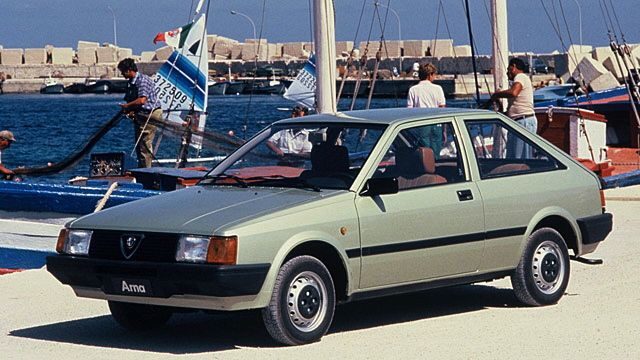1983 got off to a good start with the February announcement of the new Peugeot 205, following up the lacklustre 104 – and instant competitor for Ford’s well established Fiesta and the Austin Metro.
The 205 was seen as a car on the mark for its time, compact, comfortable and well specified. Its engine line-up included diesels, unusual indeed in early 80’s small cars – but they proved adequately refined, delivering lively performance and surprising economy. The range subsequently embraced cabriolets and commercials, but the crowning glory was surely the 205 GTI, still revered even today.
In March, 410 points allowed the Audi 100 to convincingly win the 1983 Car of the Year title, ahead of the determinedly conventional but immediately controversial Ford Sierra – and the Volvo 760. The 1984 winner turned out to be the tallish, boxy and surprisingly roomy Fiat Uno, which arrived in Britain in June 1983, as different as chalk and cheese from the 127, its immediate predecessor. Like Peugeot’s 205 it came with a range of economical engines – but in Britain diesel was not among them until 1986. As with the big-selling 127, Fiat’s small car design expertise again struck gold: over 6 million Unos were built in Italy, and some estimates suggest over 8 million examples have been manufactured worldwide.
The third significant small car of 1983 was known in Britain as the Vauxhall Nova – and the Opel Corsa elsewhere in Europe. The Nova was Vauxhall’s first – some might say overdue – foray into the Supermini arena, eventually replacing the rear-drive Chevette. Diesel power arrived here in 1987, but the Nova’s biggest claim to small car fame was its availability in 2, 3, 4, and 5 door formats, with a notably powerful GTE badged range-topper, giving definitive meaning to the term ‘complete market coverage.’ At least they resisted the temptation to call the fast one the SuperNova…
Before and after launch, the Austin Maestro played a lead role in the sort of lengthy and unfortunate comedy-tragedy that only Shakespeare or BL Ltd could possibly have engineered, bringing to mind The Sun’s glorious phrase “you couldn’t make it up.” Destined always to suffer from the legacy of BL’s darkest years, the Maestro’s unfortunate background has been well documented. In a nutshell, it took far too long to get into production, endured too many changes of mind, crossed too many boundaries, and went to market with too many unresolved problems…

Once on sale, satisfied customers were outweighed for some time by cautious potential buyers worried that BL’s well-documented problems were not yet entirely behind them. The car itself nonetheless proved comfortable, spacious and generally underrated, incorporating as it did various advanced features. It never became the overnight success its makers anticipated, but it sold steadily, and, putting things in perspective, over 600,000 had been built when, in 1994, Rover Group’s new owners BMW finally called time. Production later restarted in Bulgaria, but the cars proved unsaleable, leaving China to become the last resting place. There, incredibly, Maestro assemblies are still used in production cars today…
1983 saw two Alfa Romeo cars arrive: first was the 33 hatchback, which became one of the marque’s most successful 1980’s cars. The other was the Alfa Romeo Arna, named after the ill-fated joint venture company A.R.N.A. S.p.A.- Alfa Romeo Nissan Autoveicoli. Alfa saw it as a quick way into the VW Golf’s market sector; Nissan offered an alternative perceived as a way round European protectionism aimed at minimising the impact of Japanese vehicle imports on local manufacture.
Body panels and rear suspensions from Japan were consigned to a new plant in Italy, where assembly took place utilising Alfa Romeo engines, transmission and front suspension. The resulting curate’s egg was launched at the 1983 Frankfurt motor show: it looked like the Nissan Cherry and drove like the curious hybrid it was, built to standards that had commentators and buyers alike united in the common cause of hand-wringing despair. Then, in the sort of monumental marketing mistake that British Leyland had previously nurtured as its territory alone, the Nissan Cherry Europe followed in 1984. Sales of both cars were, ahem, modest: just two of each are thought to survive in the UK today.
From the depths of despair to a pinnacle of respectable longevity: the mark 2 Volkswagen Golf was another car revealed in 1983. Others include the Ford Orion, saloon relative of the oh-so-popular Ford Escort, and the Land Rover 110 with new coil spring suspension – provoking diehard traditionalists into pursing lips in disbelief. Renault launched their big 25 and the 11 hatchback, and the sporty Honda CRX and third generation Civic both went on sale. There was also another new incarnation of the multi-million selling Toyota Corolla, and… oh, yes, the Fiat Regata.
How soon we forget….
Dave Moss has a lifetime connection with the world of motoring. His father was a time-served skilled engineer from an age when car repairs really meant repairs: he ran his own garage from the 1930's to the 60's, while Mum was the boss's secretary at a big Austin distributor. Both worked their entire lives in the motor trade, so if motor oil's not in Dave's blood, its surely a very close thing.
Though qualified in Electronics, for Dave it seemed a natural step into restoring a succession of classic cars, culminating in a variety of Minis. Writing and broadcasting about these, and a widening range of motoring matters ancient and modern, gathered pace in the 1970's and has taken over since. Topics nowadays range across the modern motoring mainstream to the offbeat and more arcane aspects of motoring history, and outlets embrace books, websites national and international magazines, newspapers, radio programmes, phone-ins and guest appearances. Spare time: hard graft on the garage floor attending to vehicles old and new. Latest projects: that 1968 Mini Cooper S has finally moved again after 30 years, and when the paint is finished, the 1960 Morris Mini 850 will also soon be ready for the road again...

